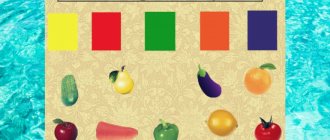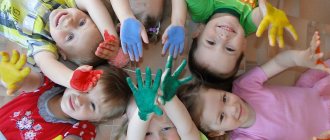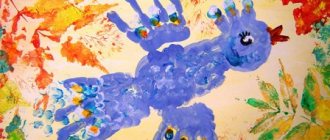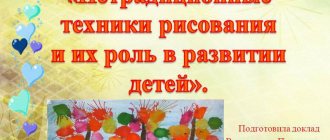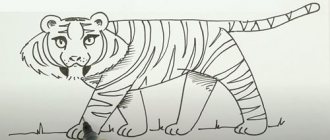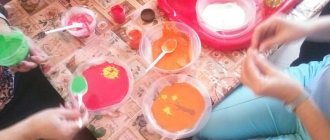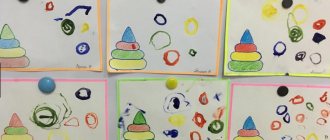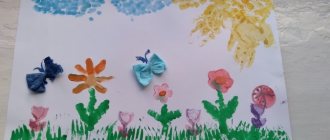Unconventional drawing techniques at an early age
Zueva Svetlana Vasilievna
Unconventional drawing techniques at an early age
Art, as we know, plays a significant role in the life of society. It is this circumstance that prompts pedagogical science to study it in the possibility of developing the creative personality of a preschooler.
The artistic development of a child begins from the moment of his birth. By the age of three, a child goes through a huge developmental path. He mastered many movements that require more subtle and differentiated movements, for example, manipulation with a pencil and clay.
The child is not indifferent to the environment and his appearance. He prefers bright, beautiful toys, dishes, pictures, and begins to navigate many words that help him in his practical activities.
Artistic development presupposes the development of prerequisites for value-semantic perception of the world and nature; the formation of an aesthetic attitude towards the surrounding world; formation of elementary ideas about types of art.
Non-traditional drawing techniques at an early age develop children's creative abilities, fine motor skills, children's responsiveness to joint activities, perception of color and a holistic picture of the world.
The purpose of classes in non-traditional drawing techniques is to create a sociocultural and developmental environment that ensures the creation of conditions for the artistic development of a child, opening up opportunities for his positive socialization, his personal development and the development of initiative based on cooperation with adults and peers;
The objectives are:
-protection and strengthening of children’s mental health, including their emotional well-being;
-formation of a general culture of children’s personality, development of their social and moral qualities, initiative, independence and responsibility of the child;
- creating favorable conditions for the artistic development of children in accordance with their age and individual characteristics and inclinations as subjects of relationships with themselves, other children, adults and the world.
For clarity, we will give examples of several lessons with a description of working with different types of signets and other drawing tools.
Poking with a hard semi-dry brush
Means of expression: texture of color, color.
Material: hard brush, gouache, paper of any color and format, embedded silhouette of a furry or prickly animal.
Method of obtaining an image: dip the brush in gouache and hit the paper with it, holding it vertically (the brush does not fall into the water). Thus, the entire sheet, outline or template is filled. The result is an imitation of a fluffy or prickly surface.
Finger painting
Means of expression: spot, dot, short line, color.
Materials: bowls filled with gouache, thick paper of any color and format, napkins.
Method of obtaining an image: a finger is lowered into gouache and dots and specks are applied. Each finger gets a different color of paint. After work, wipe your fingers with a napkin, then the gouache is easily washed off.
Note: if possible, it is advisable to use special paint.
Potato stamp imprint
Means of expression: stain, texture, color.
Material: a bowl or plastic box containing a stamp pad made of thin foam rubber impregnated with gouache, a brush, thick paper of any color and size, potato stamps.
Method of obtaining an image: the signet is pressed against a stamp pad with paint and an imprint is applied to the paper; to obtain a different color, the bowl and signet are changed.
Imprint with eraser stamps
Means of expression: stain, texture, color.
Material: a bowl or plastic box containing a stamp pad made of thin foam rubber impregnated with gouache, a brush, thick paper of any color and size, eraser stamps.
Method of obtaining an image: the signet is pressed against a stamp pad with paint and an imprint is applied to the paper; to obtain a different color, the bowl and signet are changed.
Imprint with crumpled paper
Means of expression: stain, texture, color.
Material: saucer or plastic box containing a stamp pad made of thin foam rubber impregnated with gouache, a brush, thick paper of any color and size, crumpled paper.
Method of obtaining an image: crumpled paper is pressed against a stamp pad with paint and an imprint is applied to the paper; to obtain a different color, the saucer and crumpled paper are changed.
Drawing with cotton swabs
Means of expression: stain, texture, color.
Material: gouache, cotton swabs, napkins, paper of any color and size.
Method of obtaining an image: gouache is applied to cotton swabs by dipping, and the image is applied. For a clearer image, cotton swabs need to be changed frequently.
Drawing on wet (salute)
Means of expression: stain, texture, color.
Materials: watercolor, brush No. 5, water, napkins, gel pen.
Method of obtaining the image: the background is made with dark colors, but the paint layer must be transparent. Large and small multi-colored strokes are applied to the raw background, from which strokes are made with a helium pen in different directions. To achieve a three-dimensional effect, brush strokes are repeatedly applied to wet spots.
Drawing rain with a comb
Means of expression: stain, texture, color.
Materials: watercolor, brush No. 5, water, napkins, comb.
Method of obtaining an image: a background is created, for which the “raw” technique is also selected. The color scheme depends on the nature of the work, the image of the rain (sunny, quiet, heavy rain). Images of trees, bushes, and houses are quickly painted over a wet background. Place the sheet vertically so that the paint gradually drips off. While the sheet is still slightly damp, a comb is passed over it in a given direction, the teeth of the comb will leave marks on the paper, imitating individual raindrops.

